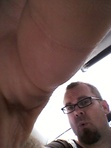In praise of Stylish Academic Writing (Sword 2012)
Stylish Academic Writing (Sword 2012)
I should say up front, some of my favourite academic scholarly (and even general audience) writers include Daniel Dennett, Steven Pinker, Brian Boyd and Richard Dawkins, among so many others... (and now also - Helen Sword!)
To explain - I've just been reading this absolutely terrific book:
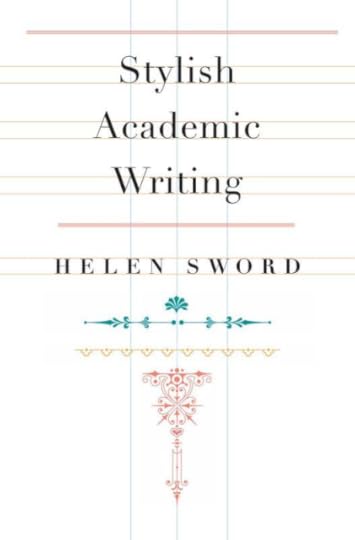 Stylish Academic Writing (Sword 2012)
Stylish Academic Writing (Sword 2012)
And, since it is such a glowingly-remarkable book, I shall now make some glowing remarks about it...!
But first some more Backstory: I am aiming to improve my academic writing style.
So with this goal in mind, recently, I have read:
The Sense of Style: The Thinking Person's Guide to Writing in the 21st Century (Pinker 2012).
and also
Clear and Simple as the Truth: Writing Classic Prose (Thomas and Turner, 1994/2017), which I also blogged about here.
At any rate, of the three, Helen Sword's (2012) book was the most enjoyable to read! I loved it.
Not least as, the methodology underpinning it reminds me so much of my Ph.D study (2016), which compares the advice in the movie screenwriting manuals to actual movie success and failure...(!)
...In short, I adore this way of thinking!
And, I soooo wish I had known about this wonderful book, when I did my Ph.D.
But better late than never, as I now aim to write a book... For both a general and academic audience. (Please wish me luck.)
In the book, Sword (2012) has presented invaluable wisdom resulting from not just one, but two wonderfully-useful studies:
The first is a study of 100 (yes, n=100!) academic writing style guide manuals from 2000-2010 (a study conducted by Louisa Shen under Sword's supervision) which examines their (a) prescriptions and (b) cautions, about various academic writing techniques.
This is a brief snapshot of some of the results of that study:
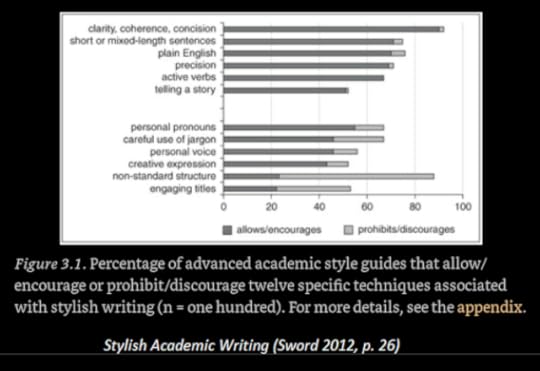
(But - you really must read the book itself, probably also including its Appendix, to understand the details of the above results, and their implications for academic writers...!)
Meanwhile the second study informing the advice in Sword (2012) is an examination of 500 academic articles (50 papers, each drawn from 10 academic disciplines: Medicine, Evolutionary Biology, Computer Science, Higher Education, Psychology, Anthropology, Law, Philosophy, History, and Literary Studies). (Sword is herself a Literary scholar, and her thinking and writing is such a pleasure to absorb!)
And, here are two more tables from the book, with some of the results from that study, results which form the majority of the book's content:
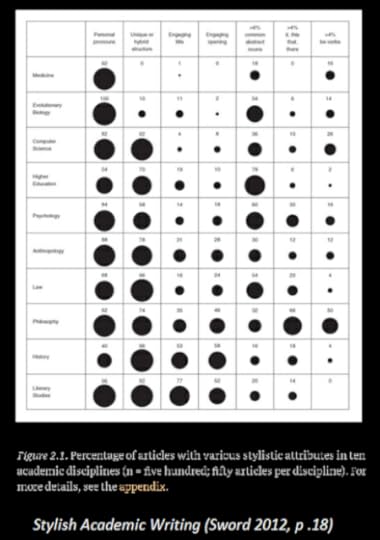
(But again - you really must read the book itself, to understand the details of the above results, and their important implications for academic writers!)
And lastly a third incredibly-informative and useful table from this excellent book:
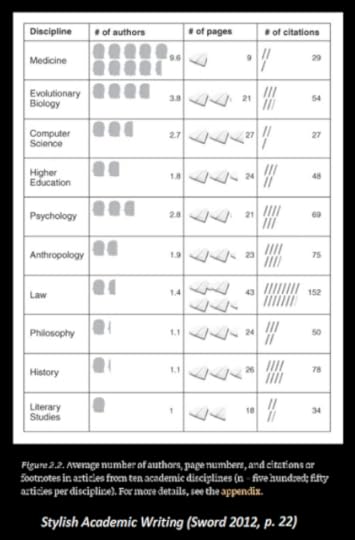
(But did I mention? - You really must read the book itself, to understand the details of the above results, and their important implications for academic writers! Not least as I have deliberately reproduced them a little bit blurry here, as I really think you should buy and read the book.)
And finally here is my very brief - and not at all comprehensive - summary of the content of book.
Sword (2012) gives sage advice:on capturing and maintaining the reader's... attention!on do's and don'ts for crafting your article - or even book - Title, and even Section and/or Chapter Headings. (Loads of nifty tricks right here!)on structuring your articles (i.e., IMRAD [Introduction, Method, Results, Analysis, Discussion] structure vs. bespoke structure vs... hybrid?)on choices you as a writer can make about deviating from disciplinary conventions (in style, form, content, tone, and more!)on imitating the common versus imitating the successful in academic writing (and, see my PhD for the same approach in movie screenwriting!)on personal voice (and the use or avoidance of personal pronouns!)on establishing bonds with your reader!on assessing different reader-types' responses (experts, colleagues, nonacademic friends, strangers... even strange friends...)on turning the abstract (ideas, concepts, theory) into the concrete (images, metaphors, analogies, scenes, anecdotes) and why it's a Very Good Idea...on avoiding abstract nounson concrete nouns and vivid verbs - and on great reasons for keeping them close together in a sentence!on passive vs active verbs!on curbing clutter. Kinda like Strunk & White's classic "Omit unnecessary words" (only: better!)on avoiding jargonitis (or, using it well, when it's actually advisable!)on why jargon is like a computer macro!on avoiding repetitionon avoiding repetitionon Genette, re: paratexts and why you really should think about them!on when to use semi-colons in: a Title! (And: When not to. And: Why) Scientifically-Proven Creativity Tricks!* e.g. "For inspiration, find an engaging title from a discipline other than your own and mimic its structure. No one in your discipline need ever know.”" (Sword 2012, pp. 74-5) on CARS vs. the problem-solution model!How to hook your readers!!! (You can even open by talking about figs from every angle! Be honest, have you ever tried it? - What about plums? ...Just sayin'.)On using: Anecdotes! Scenes! Scenarios! Quotes! Surprising facts! (and more!)The many different ways you can use: Story! And different types of story! (e.g. the research story; the researcher's story; a story from within the research, and so on!) ...Stories keep us compelled to read on! (So: you can use that!)on point-of-view... (Have you ever been an atom, an animal, an alloy? Start now! Eminent creative geniuses do this, so why shouldn't you?)on the crucial difference between the ole "Show Don't Tell" guideline (in: drama/screen media) and "Show AND Tell" (in: stylish academic writing!)on irregular verbs! And how Pinker wrote a whole half-a-book about them!on when to use: Case Studies!on Nabokov's butterflies! Did you know you can identify butterfly species by examining their genitals closely? (I thought about moving "closely" in front of examining but it wasn't as funny)on the use of Humour! And when not to use: Humor!(That's not a typo.)on Evolutionary Arms Races-!!!on how images and words have different departments in the brain! on using diagrams and/or illustrations!on using Figurative Language!on Foucault and the panopticon! (sort of)on Foucault and Derrida: What's the différance?on having a good hard look at yourself in the mirror, when you do use jargon! (Mainly, as the actress said to the bishop: What's your motivation?)on metaphors! Like: sentences as bricks!How Woolf drew a diagram of the structure of one of her stories! Because: Who's afraid of drawing a diagram?on literary allusions! (see what I did there)on Paragraph Outlines! (Like a Scene Breakdown for writing a film script; same-same, only different!)on how different citation styles (e.g. APA 6th, MLA, Chicago, etc) can actually change your modes of thinking-! e.g. In MLA you think: author, author! In APA you think: facts, facts! (Well; sort of.)on when and how and why to use Endnotes and/or Footnotes** on: expressing complex ideas clearly !!!on avoiding pretentious obscurantism !!!on how to write better Abstracts!on Watson and Crick (1953) cracking DNA and their cheeky little note in there about how: something had not escaped their attention!on: writing outside the carton! (ok, box)on borrowing from the best-est!on more on: creativity!on how: Move over, The 6 C's of creativity , because here comes... the 6 c's of stylish academic writing:
It also analyzes examples of bad academic writing, showing just exactly where they went wrong...!
And in fact - one fascinating exemplary paper made me realize - to my horror - that President Trump (sorry to even mention his name) was predicted in 2003. Namely: "What Happens When Authoritarians Inherit the Earth? A Simulation" (Altemeyer 2003). (The horror... The horror...)
And hey - get this - there's even a fun and helpful website to test your writing out on!
In short, in my view - this book is a must-read for all academic scholars!
~Enjoy!!!
--------------------
FOOTNOTES (and/or Endnotes, hard to say in a blog-post)
* I am not making this up. i.e., specifically I am not making up, this part: Scientifically-Proven Creativity Tricks!* e.g. "For inspiration, find an engaging title from a discipline other than your own and mimic its structure. No one in your discipline need ever know.”" (Sword 2012, pp. 74-5) As the scientific study of creativity shows that, borrowing ideas from neighbouring (or even, distant-!) domains of knowledge (i.e., academic disciplines) is a proven trick that a vast number of eminent creative geniuses have used... I am not making this up. I have a PhD in creativity. In: Movies. And Screenwriting.
In short, as Helen Sword (2012) advises: Imitate the successful !!! (And what's more - try and do the opposite, or at least do something different from, the not-so-successful / effective / creative !)
** - and even asterisks!
Thanks for reading!
In short I want to thank and praise Helen Sword for writing this wonderful book. I now have a much greater appreciation for great writing!
My next goal in life is to master some (or even all) of her wonderfully helpful prescriptions!
-----------------------------
Dr. Joe T. Velikovsky, Ph.D. (Communication & Media Arts)
& High-Movie-RoI Consultant (see: The StoryAlity PhD)
-------------------
`The word communication will be used here in a very broad sense to include all of the procedures by which one mind may affect another. This, of course, involves not only written and oral speech, but also music, the pictorial arts, the theater, the ballet, and in fact all human behavior... The language of this memorandum will often appear to refer to the special, but still very broad and important, field of the communication of speech; but practically everything said applies equally well to music of any sort, and to still or moving pictures, as in television." - The Mathematical Theory of Communication, (Shannon & Weaver 1949, pp. 3-4).
Also:
“I know you think you understand what you thought I said, but I'm not sure you realize that what you heard is not what I meant” - (attributed, and ironically, possibly mistakenly, to: Robert McCloskey, namely the children's book author and illustrator, date of the quote is unknown to me)
& this autosig is not even near complete yet, as
JT Velikovsky is also a:
Transmedia Writer-Director-Producer: Movies, Games, TV, Theatre, Books, Comics
Transmedia Writing Blog: http://on-writering.blogspot.com.au/
& (High-RoI) Story/Screenplay/Movie Analyst - and Evolutionary Systems Theorist
See: https://storyality.wordpress.com/
& Bio-Culture (Science & the Arts) & Transmedia Researcher
Academia link: https://aftrs.academia.edu/JTVelikovsky
See, also:
Joe Velikovsky on IMDb:
YouTube: https://www.youtube.com/joeteevee
Okay - the autosig is over. You can stop reading now.
I should say up front, some of my favourite academic scholarly (and even general audience) writers include Daniel Dennett, Steven Pinker, Brian Boyd and Richard Dawkins, among so many others... (and now also - Helen Sword!)
To explain - I've just been reading this absolutely terrific book:
 Stylish Academic Writing (Sword 2012)
Stylish Academic Writing (Sword 2012)And, since it is such a glowingly-remarkable book, I shall now make some glowing remarks about it...!
But first some more Backstory: I am aiming to improve my academic writing style.
So with this goal in mind, recently, I have read:
The Sense of Style: The Thinking Person's Guide to Writing in the 21st Century (Pinker 2012).
and also
Clear and Simple as the Truth: Writing Classic Prose (Thomas and Turner, 1994/2017), which I also blogged about here.
At any rate, of the three, Helen Sword's (2012) book was the most enjoyable to read! I loved it.
Not least as, the methodology underpinning it reminds me so much of my Ph.D study (2016), which compares the advice in the movie screenwriting manuals to actual movie success and failure...(!)
...In short, I adore this way of thinking!
And, I soooo wish I had known about this wonderful book, when I did my Ph.D.
But better late than never, as I now aim to write a book... For both a general and academic audience. (Please wish me luck.)
In the book, Sword (2012) has presented invaluable wisdom resulting from not just one, but two wonderfully-useful studies:
The first is a study of 100 (yes, n=100!) academic writing style guide manuals from 2000-2010 (a study conducted by Louisa Shen under Sword's supervision) which examines their (a) prescriptions and (b) cautions, about various academic writing techniques.
This is a brief snapshot of some of the results of that study:

(But - you really must read the book itself, probably also including its Appendix, to understand the details of the above results, and their implications for academic writers...!)
Meanwhile the second study informing the advice in Sword (2012) is an examination of 500 academic articles (50 papers, each drawn from 10 academic disciplines: Medicine, Evolutionary Biology, Computer Science, Higher Education, Psychology, Anthropology, Law, Philosophy, History, and Literary Studies). (Sword is herself a Literary scholar, and her thinking and writing is such a pleasure to absorb!)
And, here are two more tables from the book, with some of the results from that study, results which form the majority of the book's content:

(But again - you really must read the book itself, to understand the details of the above results, and their important implications for academic writers!)
And lastly a third incredibly-informative and useful table from this excellent book:

(But did I mention? - You really must read the book itself, to understand the details of the above results, and their important implications for academic writers! Not least as I have deliberately reproduced them a little bit blurry here, as I really think you should buy and read the book.)
And finally here is my very brief - and not at all comprehensive - summary of the content of book.
Sword (2012) gives sage advice:on capturing and maintaining the reader's... attention!on do's and don'ts for crafting your article - or even book - Title, and even Section and/or Chapter Headings. (Loads of nifty tricks right here!)on structuring your articles (i.e., IMRAD [Introduction, Method, Results, Analysis, Discussion] structure vs. bespoke structure vs... hybrid?)on choices you as a writer can make about deviating from disciplinary conventions (in style, form, content, tone, and more!)on imitating the common versus imitating the successful in academic writing (and, see my PhD for the same approach in movie screenwriting!)on personal voice (and the use or avoidance of personal pronouns!)on establishing bonds with your reader!on assessing different reader-types' responses (experts, colleagues, nonacademic friends, strangers... even strange friends...)on turning the abstract (ideas, concepts, theory) into the concrete (images, metaphors, analogies, scenes, anecdotes) and why it's a Very Good Idea...on avoiding abstract nounson concrete nouns and vivid verbs - and on great reasons for keeping them close together in a sentence!on passive vs active verbs!on curbing clutter. Kinda like Strunk & White's classic "Omit unnecessary words" (only: better!)on avoiding jargonitis (or, using it well, when it's actually advisable!)on why jargon is like a computer macro!on avoiding repetitionon avoiding repetitionon Genette, re: paratexts and why you really should think about them!on when to use semi-colons in: a Title! (And: When not to. And: Why) Scientifically-Proven Creativity Tricks!* e.g. "For inspiration, find an engaging title from a discipline other than your own and mimic its structure. No one in your discipline need ever know.”" (Sword 2012, pp. 74-5) on CARS vs. the problem-solution model!How to hook your readers!!! (You can even open by talking about figs from every angle! Be honest, have you ever tried it? - What about plums? ...Just sayin'.)On using: Anecdotes! Scenes! Scenarios! Quotes! Surprising facts! (and more!)The many different ways you can use: Story! And different types of story! (e.g. the research story; the researcher's story; a story from within the research, and so on!) ...Stories keep us compelled to read on! (So: you can use that!)on point-of-view... (Have you ever been an atom, an animal, an alloy? Start now! Eminent creative geniuses do this, so why shouldn't you?)on the crucial difference between the ole "Show Don't Tell" guideline (in: drama/screen media) and "Show AND Tell" (in: stylish academic writing!)on irregular verbs! And how Pinker wrote a whole half-a-book about them!on when to use: Case Studies!on Nabokov's butterflies! Did you know you can identify butterfly species by examining their genitals closely? (I thought about moving "closely" in front of examining but it wasn't as funny)on the use of Humour! And when not to use: Humor!(That's not a typo.)on Evolutionary Arms Races-!!!on how images and words have different departments in the brain! on using diagrams and/or illustrations!on using Figurative Language!on Foucault and the panopticon! (sort of)on Foucault and Derrida: What's the différance?on having a good hard look at yourself in the mirror, when you do use jargon! (Mainly, as the actress said to the bishop: What's your motivation?)on metaphors! Like: sentences as bricks!How Woolf drew a diagram of the structure of one of her stories! Because: Who's afraid of drawing a diagram?on literary allusions! (see what I did there)on Paragraph Outlines! (Like a Scene Breakdown for writing a film script; same-same, only different!)on how different citation styles (e.g. APA 6th, MLA, Chicago, etc) can actually change your modes of thinking-! e.g. In MLA you think: author, author! In APA you think: facts, facts! (Well; sort of.)on when and how and why to use Endnotes and/or Footnotes** on: expressing complex ideas clearly !!!on avoiding pretentious obscurantism !!!on how to write better Abstracts!on Watson and Crick (1953) cracking DNA and their cheeky little note in there about how: something had not escaped their attention!on: writing outside the carton! (ok, box)on borrowing from the best-est!on more on: creativity!on how: Move over, The 6 C's of creativity , because here comes... the 6 c's of stylish academic writing:
"communication, craft, creativity"
and
"concreteness, choice and courage"
(Sword 2012, p. 173)But you will really have to read the book to register the details. (Words are useful tools of information-compression but sometimes you need to read the long version. Not just: my riskily glib and frivolous bullet-point summary of it!)The book provides wonderful samples of stylish academic prose throughout, including examples by Pinker, Dennett, Boyd and Dawkins! (Yaaaaay! Found my peeps!)
It also analyzes examples of bad academic writing, showing just exactly where they went wrong...!
And in fact - one fascinating exemplary paper made me realize - to my horror - that President Trump (sorry to even mention his name) was predicted in 2003. Namely: "What Happens When Authoritarians Inherit the Earth? A Simulation" (Altemeyer 2003). (The horror... The horror...)
And hey - get this - there's even a fun and helpful website to test your writing out on!
"THINGS TO TRY
• For a playful insight into what ails a sagging paragraph, go to the Writer’s Diet Web site (http://www.writersdiet.com) and paste a sample of your writing (one thousand words maximum) into the online WritersDiet test, a free diagnostic tool designed to tell you whether your sentences are “flabby or fit.” (Sword 2012, p. 60)
In short, in my view - this book is a must-read for all academic scholars!
~Enjoy!!!
--------------------
FOOTNOTES (and/or Endnotes, hard to say in a blog-post)
* I am not making this up. i.e., specifically I am not making up, this part: Scientifically-Proven Creativity Tricks!* e.g. "For inspiration, find an engaging title from a discipline other than your own and mimic its structure. No one in your discipline need ever know.”" (Sword 2012, pp. 74-5) As the scientific study of creativity shows that, borrowing ideas from neighbouring (or even, distant-!) domains of knowledge (i.e., academic disciplines) is a proven trick that a vast number of eminent creative geniuses have used... I am not making this up. I have a PhD in creativity. In: Movies. And Screenwriting.
In short, as Helen Sword (2012) advises: Imitate the successful !!! (And what's more - try and do the opposite, or at least do something different from, the not-so-successful / effective / creative !)
** - and even asterisks!
Thanks for reading!
In short I want to thank and praise Helen Sword for writing this wonderful book. I now have a much greater appreciation for great writing!
My next goal in life is to master some (or even all) of her wonderfully helpful prescriptions!
-----------------------------
Dr. Joe T. Velikovsky, Ph.D. (Communication & Media Arts)
& High-Movie-RoI Consultant (see: The StoryAlity PhD)
-------------------
`The word communication will be used here in a very broad sense to include all of the procedures by which one mind may affect another. This, of course, involves not only written and oral speech, but also music, the pictorial arts, the theater, the ballet, and in fact all human behavior... The language of this memorandum will often appear to refer to the special, but still very broad and important, field of the communication of speech; but practically everything said applies equally well to music of any sort, and to still or moving pictures, as in television." - The Mathematical Theory of Communication, (Shannon & Weaver 1949, pp. 3-4).
Also:
“I know you think you understand what you thought I said, but I'm not sure you realize that what you heard is not what I meant” - (attributed, and ironically, possibly mistakenly, to: Robert McCloskey, namely the children's book author and illustrator, date of the quote is unknown to me)
& this autosig is not even near complete yet, as
JT Velikovsky is also a:
Transmedia Writer-Director-Producer: Movies, Games, TV, Theatre, Books, Comics
Transmedia Writing Blog: http://on-writering.blogspot.com.au/
& (High-RoI) Story/Screenplay/Movie Analyst - and Evolutionary Systems Theorist
See: https://storyality.wordpress.com/
& Bio-Culture (Science & the Arts) & Transmedia Researcher
Academia link: https://aftrs.academia.edu/JTVelikovsky
See, also:
Joe Velikovsky on IMDb:
YouTube: https://www.youtube.com/joeteevee
Okay - the autosig is over. You can stop reading now.
Published on September 29, 2018 09:29
No comments have been added yet.

